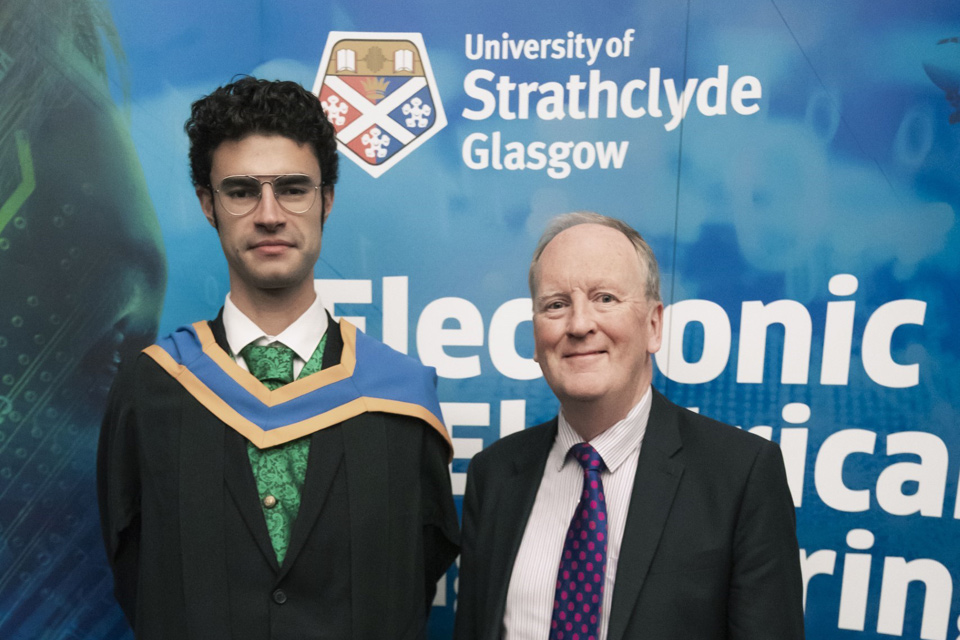For more than four decades, George Matich worked at Leonardo and its predecessors, culminating in his role as Chief Technologist, where he worked on major NATO programmes and had a strong connection to the US Air Force Laboratories. Outside of this, he made an immense contribution to academia, which was recognised in August 2020 when he became a Visiting Professor in the Department of Electronic & Electrical Engineering (EEE) at the University of Strathclyde.
Contributing to academia
It was at the University of Strathclyde where George interacted closely with Professor John Soraghan and Dr Gaetano Di Caterina in the Centre for Signal & Image Processing (CeSIP), starting with exploratory discussions in 2015-2016 relating to lack of neuromorphic (brain-like) technology activities in the UK, in comparison to those in Europe, Asia and the US. This resulted in the establishment of the university’s Neuromorphic Sensor Signal Processing (NSSP) Laboratory in August 2017.
Today, the lab features state-of-the-art neuromorphic technologies and associated software environments, some of which were donated by George through Leonardo. Furthermore, George’s support led the lab to work closely with groups in New York State’s Syracuse University, Waterloo University and the Advanced Brain Research group in Canada, and University College London and University of Cambridge in the UK. These collaborative activities continue to this day. The NSSP Lab is also a member of the Intel Neuromorphic Research Community (INRC) which provides direct access to the latest neuromorphic technology and opportunities from Intel.
Since its establishment, the NSSP Lab has begun 9 PhD (4 studentships with financial support from Leonardo) and 2 MPhil research programmes in the field of neuromorphic sensor signal processing. It is poignant that its first PhD research programme, by Paul Kirkland, entitled ‘Less is More: The Neuromorphic Engineering Advantage’, featured George as co-author on several papers.
A passion for neuromorphic technologies
As a result of George’s vision of what was required within Leonardo in the area of novel neuromorphic technologies, he secured a five-year funding package from the company that allowed Dr Di Caterina to become the Leonardo Lecturer at the University of Strathclyde in February 2019, with particular emphasis on neuromorphic technologies and applications.
From 2016 onwards, George visited the EEE Department every three months on average. As well as meeting Leonardo-funded research students, he interacted with many of the other neuromorphic and DNN research students during his visits. He also engaged with Final Year Project, MEng and MSc project students, offering them valuable feedback and advice, and made several very useful technology donations that allowed many of these projects to progress.
“Through George’s support and engagement with CeSIP, the EEE Department now has a state-of-the-art machine learning laboratory that focusses on core engineering issues in the evolving research field of how to produce low size, weight and power solutions for future machine learning and AI challenges,” says Leonardo lecturer Dr Di Caterina. “The laboratory is vital to much of the research now undertaken by the University students, with many of the aspects within this environment now part of the new MSc in Machine Learning and Deep Learning that we established in 2019.”
Funding future research into signal processing, communications and machine learning
Founded in 2021 in George’s memory, through donations raised by his family, the George Matich Memorial Award is conferred annually on two outstanding projects (one Fourth Year Individual project, and one MSc project) in the EEE Department, in the fields of signal processing, communications and machine learning, with relevance for national defence and security.
George’s sister, Lucia Haggie, said: “George was very excited and honoured about his role as Visiting Professor in the EEE Department, and was looking forward to this with great expectations. He is sadly missed by us all. However his legacy will live on in what was achieved in a relatively short period of time, and, no doubt, what will be realised in the future.”
2023 awards
In 2023, the George Matich Memorial Award was conferred on two people. The MSc project was by John McMenemy, who evaluated the use of machine learning, in particular Support Vector Machine (SVM), to accurately classify different mineral types using hyperspectral images from the recently launched NASA’s EMIT instrument. The EMIT instrument provides satellite data measuring reflectance from atmospheric mineral dust in arid regions on the Earth.

George Matich Memorial Award recipient John McMenemy (left) alongside Leonardo's University Liaison Allan Colquhoun
With such high-dimensionality datasets, the main challenge was to process and interpret the data for an effective classification of minerals based on their spectral response, leading to pixel-wise classification maps. SVM led to high classification accuracy, which could be combined with Principal Component Analysis (PCA) for dimensionality reduction (pre-processing) reducing hardware resources without significant loss of accuracy.
Results demonstrated the potential of machine learning tools for satellite data processing and interpretation, improving our understanding of atmospheric mineral dust, vegetation and water bodies in arid regions, and its impact on the Earth system.
Ryan Provan’s graduate project focused on developing a more flexible solution to perform spectrum occupancy monitoring by better utilising the Radio Frequency spectrum.
His researched identified that the current Spectrum Sensing technique (known as energy detection) could be improved to more accurately determine the occupancy state of a channel by better distinguishing each signal from the ‘energy noise’.
During his project, Ryan designed a hardware accelerated variable bandwidth solution, implemented a method to vary the energy sample window used in the energy core, and designed a hardware accelerated automated threshold IP core. This custom IP core can be used as a building block in the wider network systems that the Strathclyde Software Defined Radio Lab is helping build around Scotland, including on 5G RuralFirst, which is demonstrating how 5G technologies can deliver connectivity for the UK's rural businesses and communities.

